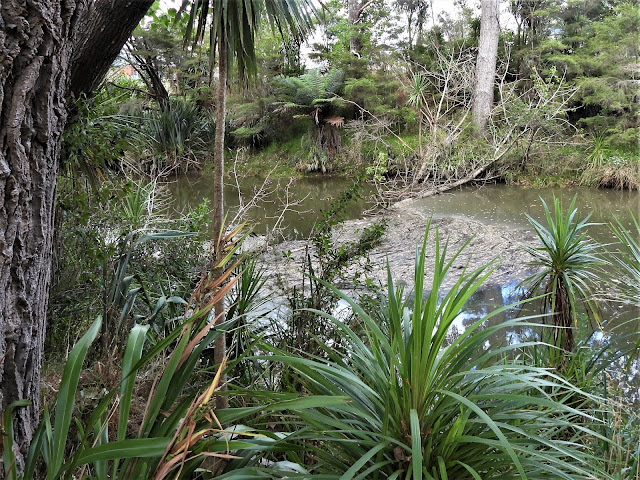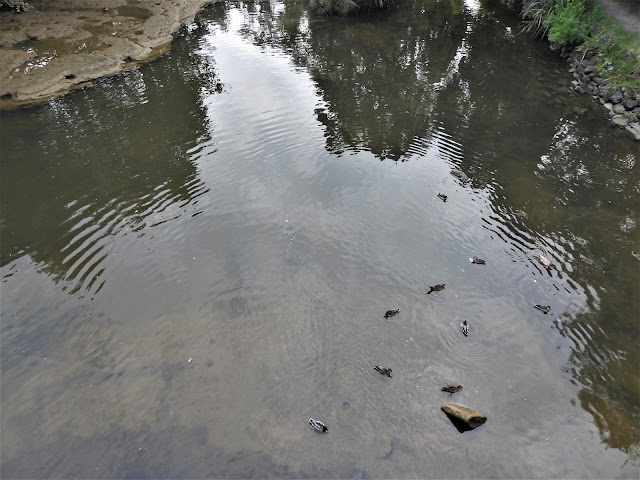I am one of the most fortunate of grandparents ever, in my opinion. For several years, when they were young, I walked our grandsons to and from school every day. It was their primary school and each morning and/or afternoon, Jeanne and I shared the pleasure of accompanying the boys to and from Summerland.
One day, it occurred to me that the school was inhaling in the morning and exhaling the students and caregivers in the afternoon. There were easily as many grandparents as there were parents walking the kids to school each day, and I reveled in the joy of being part of the process.
I was reminded of this form of 'respiration' that I saw at the school recently when I walked along the Opanuku Stream.
We, at Waitakere Gardens, are located less than two miles from the bay that leads into the Pacific Ocean. Our stream is in a constant, and rhythmic 'respiration' of sorts of its own, as the tides rise and fall along part of its length, culminating at the bridge near our village.
I have come to recognize that the stream is never static. It is always rising and falling, much like our own chests do as we breathe or like the school does with its daily influx and outflow of families.
I like being able to feel the earth and moon communicate, if you can call it that. The force that they follow and that rules the universe is visible daily in my little stream. While I can't feel them directly, I know how real they are by observing their effect. Further, I have seen evidence that the birds are even more aware than I am of this power.
Let me show you what I see when I walk.
This is a bit of the Opanuku at low tide.
This picture was taken from roughly the same point at high tide. That's a sleeping duck which has floated at least 80 yards downstream since I've been watching and taking pictures. Who knows where it'll be when it wakes up?
Low again,
and high tide at the same spot.
This tiny rapids is just downriver from the previous pictures' location.
This upcoming video was shot at approximately the same location, but the tide is quickly covering these rocks and is causing the stream to appear to be running 'uphill.'
Just after you start this video, let me suggest that you stop it for a moment. Right about in the center of the picture, you'll see two bits of rock sticking out of the water. They are small, just a few inches across and a leaf floats first by the smaller, and then floats up to the larger.
You'll notice that by the time I pan back with my camera and show them again near the end of this 1-minute video, that the smaller of the two rock 'islands' is gone, already covered by the incoming tide.
Notice too, all the fish that are swimming around in the incoming waters. The water is hard to see into I know. The lighting isn't ideal and the surface of the water looks dirty. It's actually a heavy layer of pollen. If you keep watching however, you'll see that the water is teeming with fish.
Here is a picture of the Oratia Stream, which passes within about 100 yards from the Opanuku at one point. (That's why they're called the Twin Streams.)
The stream normally flows from the left to the right. What I'd like you to notice though is that there is a large semi-circle of debris and pollen accumulated on the down-stream side of a fallen tree that is hung-up in the water. That's because of course, the tide is making the stream run upstream right now.
Here is a photo from the same place at low tide.
At the beginning of this post, I mentioned that I felt the birdlife along the stream was even more attuned to its power than I was. This is why I said that.
One my way back from taking some of these pictures, I was walking across the bridge over the Opanuku. I heard a bunch of ducks making a racket down below.
As you can see, they are grouped together and were very animated. Normally, the ducks seem to stay together in pairs and certainly don't make a racket.
The water is nearing the top of the rock shelf on the upper left of the picture. That means the tide is coming in. I think the ducks were excited about that and saying so. Mallards do eat small fish, although vegetation is their preferred food.
These folks know it's time for the small fish to come in as well. I see them here a lot. I don't know if they are catching these small fry for bait or for consumption. A frying pan full of small fish makes every bit as good a meal as a pan full of one big one. They use a very fine net that is about 20 inches square and supported by four strings. They lay it on the bottom and then rapidly pick it up to trap the fish.
I took the two pictures just above this one before I went into the grocery store to buy a few items. By the time I came back to the bridge, maybe 15 minutes later, and took the picture below, the rising tide had completely covered the rock ledge, visible in the first picture. I took a wider angled picture this time to show the ledge was completely submerged.
The ducks at this point in time were all under the bridge, but still making a ruckus, maybe arguing about who would go first through the seafood buffet line.
I said that I was fortunate earlier and it's true. I've had a meaningful retirement, and it continues. I see our grandsons growing and I continually learn about the natural world, a-la-New Zealand as I observe it. I have even been able to watch how the planets and stars cycle during the year. I could claim that the whole universe seems to be 'breathing,' but that would be just too corny, so I won't.
But I haven't yet seen everything there is to see, so I will keep watching... -djf
p.s.
One more photo. I went back across the bridge a little later. Look how high the tide got!














I liked your post, Dad! I wonder how the stream will be looking today, with the downpours we've gotten today??
ReplyDeleteI was just considering going down there with the camera to find out. I'll let you know.
ReplyDeleteFascinating post Doug! I believe the whole universe does have a rhythm and when you break it into smaller pieces down to our sun, planet and moon the tides are all part of it.
ReplyDeleteWatching the tide coming in in these pictures and in your video is mesmerizing - happening so serenely and then suddenly everything is submerged. It looks like at the highest point in your last picture it's at least 4 feet deep. And not only that, it has turned into pea soup!
Yeah, I love to watch it.
ReplyDelete